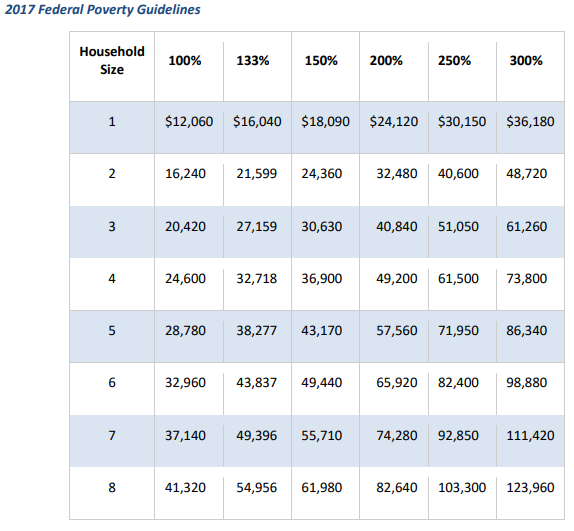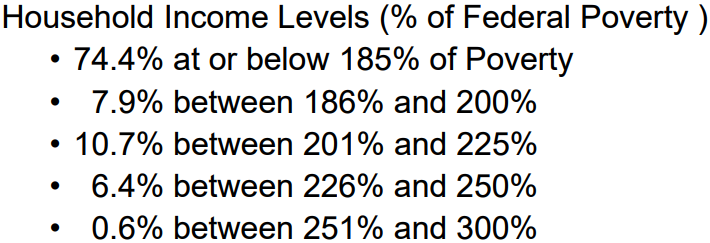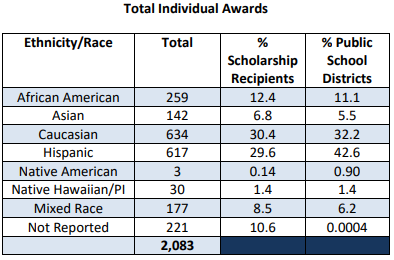
Opportunity Scholarships overwhelmingly benefit low-income, underserved populations
A common refrain used by school-choice opponents is to falsely assert that programs like Nevada’s Opportunity Scholarships only benefit the wealthy. Taxpayers shouldn’t be forced to subsidize the private education of students whose families can already afford one, they argue.
Armed with this and other misleading talking points, the Nevada State Education Association is out to abolish Nevada’s Opportunity Scholarship program — which presently serves over 2,000 students.
However, in reality, this program explicitly excludes wealthy families, and is only available to children from low- and middle-income households.
To be eligible for a scholarship, students must live in a household whose income falls below 300 percent of the Federal Poverty Line, as outlined below:

Source: Nevada Department of Education, 2018
Thus, for even the “wealthiest” students who are eligible to apply for scholarships, their total household income (for a family of four) cannot be greater than $73,800.
That income cutoff, quite literally, guarantees that only students from lower- and middle-income households can receive Opportunity Scholarships.
New data highlighted during last week’s Interim Legislative Committee on Education meeting gives us a much better insight into who, exactly, is benefiting from Nevada’s Opportunity Scholarship program:

Source: AAA Scholarship Foundation, 2018
The AAA Scholarship Foundation, one of three scholarship-granting organizations (SGOs) for the 2017-18 academic year, provided the above information to the committee regarding income levels for students to whom the organization awarded scholarships.
Contrary to the usual anti-choice criticisms, these numbers clearly indicate that students at the lowest end of the income spectrum — those in households earning less than 185 percent of the Federal Poverty Line — are the greatest beneficiaries of Opportunity Scholarships, accounting for nearly three-quarters of all AAA scholarships awarded during the most recent school year.
Though AAA accounted for only 809 of 2,083 total scholarship recipients for 2017-18, a scholarship report submitted to the committee by the Department of Education demonstrates that the two other SGOs — Dinosaurs and Roses, and the Education Fund of Northern Nevada — awarded scholarships along similar income lines:

Source: Nevada Department of Education, 2018; US Census Bureau
As shown above, the average scholarship recipient spanning all three SGOs came from a household whose income was between $43,000 and $46,000. A household income of $46,000 at the upper-end of this range corresponds to approximately 187 percent of the Federal Poverty Line.
For comparison, Nevada’s average household income is greater than $73,000.
The Department of Education’s scholarship report also contains key information concerning the race of scholarship recipients, as shown below:

Source: Nevada Department of Education, 2018
This distribution indicates that minority students participate actively in the Opportunity Scholarship program. Relative to their population as a percentage of student enrollment, certain minority groups were, in fact, overrepresented during 2017-18 — African American students, for example, accounted for 12.4 percent of all scholarships, while representing only 11.1 percent of Nevada student enrollment.
By this same measure, Caucasian scholarship students were actually underrepresented during the 2017-18 school year — 30.4 percent of total scholarships versus 32.3 percent of the student population.
Thus, the latest official data from the Department of Education shows that the Opportunity Scholarship program is doing precisely what it was designed to do: Help historically-underserved Nevadans find a school that better suits their individual needs.
When considering the merits of the program, lawmakers should ignore the misleading rhetoric of the special interests that are concerned about losing their monopoly over education. Instead, they should take a close look at how the program actually works, and who is benefiting.
Daniel Honchariw is senior policy analyst at NPRI.